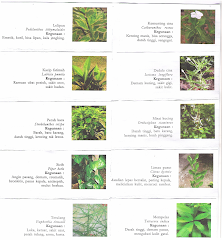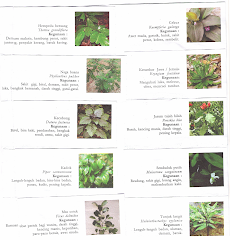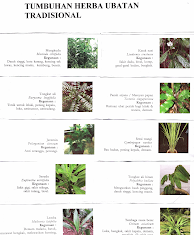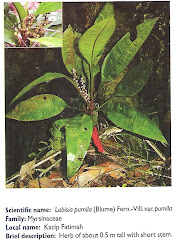Environmental Impacts of Logging
THE WELL-DOCUMENTED environmental impacts of logging167 are summarised below. Environmental impact assessments of logging operations in a number of different countries (Papua New Guinea, Solomon Islands and Cameroon, for instance) clearly demonstrate that destructive logging practices using heavy machinery seriously reduce the forest's ability to carry out vital environmental and ecological functions.
Watershed Management and Soil Erosion
Forests provide a buffer to filter water and to hold soil in place. They sustain water and soil resources through recycling nutrients. In watersheds where forests are degraded or destroyed, minimum flows decrease during the dry season, leading to drought, while peak floods and soil erosion increase during
Tributary meets Melinau River, upper reaches of Baram river. Tributary water (left of picture), from preserved, non-logged and non-eroded watershed. Water from main river is cloudy with sediment from logging operations.
Flooding along the Baram River in Sarawak has increased significantly since logging began, the major floods occurring in 1979 and 1981.168 Massive floods, directly linked to excessive logging, have caused hundreds of deaths in the Philippines169 and Thailand.170
Much of the current logging carried out in Sarawak and other places is on steep lands dominated by surface materials that are highly susceptible to erosion when disturbed.171 Data collected by the Malaysian Department of Environment in 90 long-term sampling site locations within 21 river basins has detected incredibly high suspended sediment loads in most rivers and tributaries. This mainly originates from upstream soil erosion caused by the indiscriminate construction of logging roads and camps, skid trails and logging itself.172 Dr Saulei of the University of Papua New Guinea also blames the logging industry for 'accelerating erosion, weathering and humus decomposition, and leading to widespread formation of soils with low nutrient and absorptive capacities'.173
A skid track with severe erosion. More than a metre of topsoil has been lost and the bedrock exposed along many metres of this skid track on Isabel Island, Solomon Islands (see Kumpulan Emas, page 44).
The scale of inputs of mobilised sediment is clearly seen in this photograph where many tonnes of material are being made transportable from machinery-mediated topsoil disturbance and the loss of vegetative cover and litter layers.
Local Climate Regulation
Beside the implications of large-scale logging for global warming, drastic changes in precipitation are direct and immediate when the forest cover is removed.174 Changes in transpiration result in a greater intensity of tropical rainfall, enhancing both run-off and erosion, even if the total amount of rainfall remains unchanged. Forest loss can also make rainfall more erratic, thus lengthening dry periods.175
Forest Fires
Most of the destructive forest fires that have recently raged out of control across the world, from the Amazon to Indonesia, are widely acknowledged to have been either started by and/or exacerbated by logging and agricultural development companies, such as the oil palm industry. One of the most detailed studies on the effects of fires in Kalimantan, Indonesia, concludes that the considerable decrease in foliage and related changes in the stand structure, increase of albedo, and horizontal and vertical air movements caused by fires, may produce significant and lasting effects on the regional climate.176
Impacts on the Marine Environment
Unsustainable logging mobilises debris that not only finds its way into the streams and rivers but also to the marine environment, where it damages mangroves and coral reefs, habitats crucial for aquatic life. In the Solomon Islands, the unique Marovo Lagoon, a proposed World Heritage Site, is threatened by the ecologically-destructive logging operations occurring in the surrounding forests. In Papua New Guinea, coral reefs have been destroyed to construct log ponds.
Loss of Biodiversity
Logging often destroys natural habitats, resulting in the loss of biodiversity and sometimes leading to the local, and possibly global, extinction of species. Although estimates of the rates of loss vary, few deny the reality of the current losses of both flora and fauna.177
According to a joint report by the Worldwide Fund for Nature and the Sarawak Forest Department, "Logging causes immediate forest disturbances, long-term habitat changes (e.g. damage to food trees and salt-licks), increased hunting by timber company workers and availability of logging roads as hunting routes. The destruction of wildlife from habitat loss must be recognised to be on an enormous scale".178 In Central Africa, the opening-up of the forest by logging facilitates the illegal hunting of wildlife, including protected species such as primates, and is leading to a decline in wildlife populations.179 Deterioration in water quality has caused a decline in fish stocks and has affected aquatic biological diversity because indigenous animals and plant life are highly vulnerable to oxygen depletion, suspended particulate matter and a lack of light.180
Even so called selective logging severely affects the complex and rich biodiversity of forests through excessive damage to residual stands, destruction of other plant and tree species and the creaming-off of species which are the most valuable for timber. An FAO study in Malaysia has shown that as much as 50% of the standing forest may be damaged and the surface soil destroyed when up to 30% of the ground surface is exposed. During silvicultural treatment in logging operations in Sarawak, so-called uneconomic forest species are deliberately poisoned. This reduces the complexity and species diversity of the tropical forests to only 10% of the original condition, resulting in the systematic elimination of tree genetic resources and contamination of the environment.181 According to the IUCN the most frequently recorded of all threats to globally endangered tree species is 'felling'.182
Destructive logging practices using heavy machinery seriously reduce the forest's ability to carry out vital environmental and ecological functions.
أَلَمْ تَرَ أَنَّ اللَّهَ يُسَبِّحُ لَهُ مَنْ فِي السَّمَاوَاتِ وَالأرْضِ وَالطَّيْرُ صَافَّاتٍ كُلٌّ قَدْ عَلِمَ صَلاتَهُ وَتَسْبِيحَهُ وَاللَّهُ عَلِيمٌ بِمَا يَفْعَلُونَ Tidakkah kamu tahu bahwasanya Allah: kepada-Nya bertasbih apa yang di langit dan di bumi dan (juga) burung dengan mengembangkan sayapnya. Masing-masing telah mengetahui (cara) solat dan tasbihnya, dan Allah Amat Mengetahui apa yang mereka kerjakan. an-Nur:41
Tazkirah
Sami Yusuf_try not to cry
mu'allim Muhammad Rasulullah Sallallahu alaihi waSalam
ummi_mak_mother_ibu_Sami Yusuf
zikir Tok Guru Nik Abdul Aziz Nik Mat Mu'allimul Mursyidi
syeikh masyari afasi
ruang rindu
song
Arisu Rozah
Usia 40

Mudah mudahan diluaskan rezeki anugerah Allah
usia 40 tahun

UPM

Kuatan Pahe Darul Makmur
pemakaian serban semsa menunaikan solat_InsyaAllah ada sawaaban anugerah Allah
Rempuh halangan

Abah_menyokong kuat oengajian Ijazah UPM

usia 39 tahun

usia 23 tahun_UPM
An_Namiru

Ijazah Pengurusan Hutan UPM

General Lumber_Nik Mahmud Nik Hasan

Chengal

Tauliah

Semasa tugas dgn general lumber

PALAPES UPM

UPM

Rumah yang lawa

Muhammad_Abdullah CD
semasa bermukim di Kuatan Pahe Darul Makmur
Ijazah

air terjun

Borneo land

GREEN PEACE
GREEN PEACE
Kelang

Ahlul Bayti_ Sayid Alawi Al Maliki

Asadu_ Tenang serta Berani

atTiflatul Falasthiniin

Sayid Muhammad Ahlul Bayt keturunan Rasulullah

AnNamiru_SAFARI_Kembara

AnNamiru_resting

Hamas

sabaha anNamiru fil nahri

Namir sedang membersih

Tok Guru Mualimul_Mursyid

An_Namiru
.jpg)
Namir_istirehat
.jpg)
SaaRa AnNamiru fil_Midan
.jpg)
Renungan Sang Harimau_Sabaha AnNamiru
.jpg)
Syaraba AnNamiru Ma_A
.jpg)
AnNamiru_Riadhah
.jpg)
AnNamiru_Riadhah
.jpg)
AnNimru ma_A waladuha
Namir fil_Ghabi (sebut Robi...
Namir

AdDubbu_Beruang di hutan

Amu Syahidan Wa La Tuba lil_A'duwwi

AsSyahid

Namir

Tangkas
najwa dan irah

sungai

najwa

najwa

Kaabatul musyarrafah

unta

Jabal Rahmah

masjid nabawi

masjid quba

dr.eg

najwa dan hadhirah

along[macho]
![along[macho]](https://blogger.googleusercontent.com/img/b/R29vZ2xl/AVvXsEjuMi7D33CmR0_KXrCW2XigfLcUuQurcvtqOS139ncCwEzCyB-jUopk7QK7anADIenJEm2S0N6gAY1ubnACYXewgiAsI3rBjnLTawM39alLL-rEopOoVqn0w5WpLhPJH3hrXNtchEhgtyaI/s240/P7150023.JPG)
harissa dan hadhirah

adik beradik
Tongkat Ali

Tongkat Ali
herba kacip Fatimah

herba Kacip Fatimah
hempedu beruang

hempedu beruang
hempedu bumi

hempedu bumi
herba misai kucing

herba misai kucing
herba tongkat Ali
.png)
Tongkat Ali
Ulama'

Ulama'
kapal terbang milik kerajaan negara ini yang dipakai pemimpin negara

kapal terbang
Adakah Insan ini Syahid

Syahid
Tok Ayah Haji Ismail

Saifuddin bersama Zakaria

Dinner....
Sukacita Kedatangan Tetamu
Pengikut
Kalimah Yang Baik

Ubi Jaga

Ubi Jaga
Arkib Blog
Burung Lang Rajawali

Chinese Sparrowhawk
Kelicap Mayang Kelapa

Brown-Throated Sunbird
Kopiah

Pokok Damar Minyak

Kacip Fatimah

Mengkudu Akar



